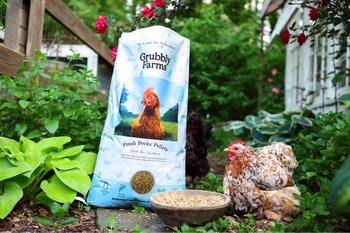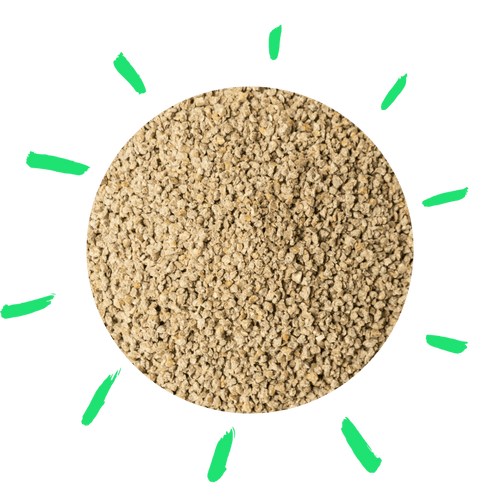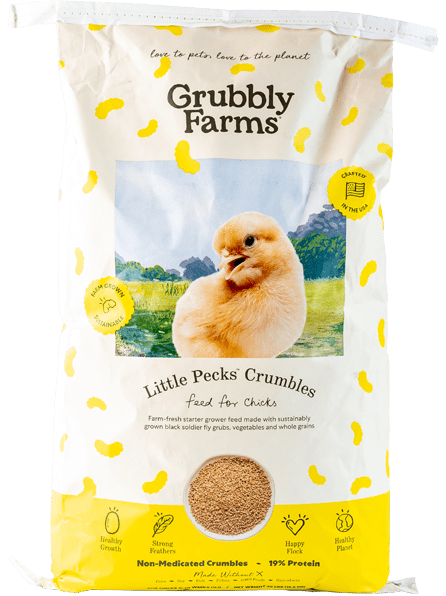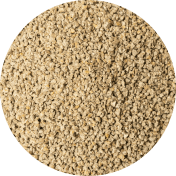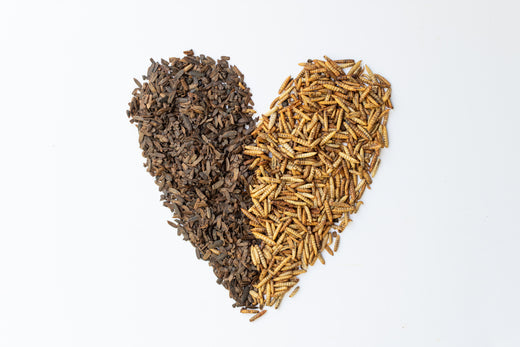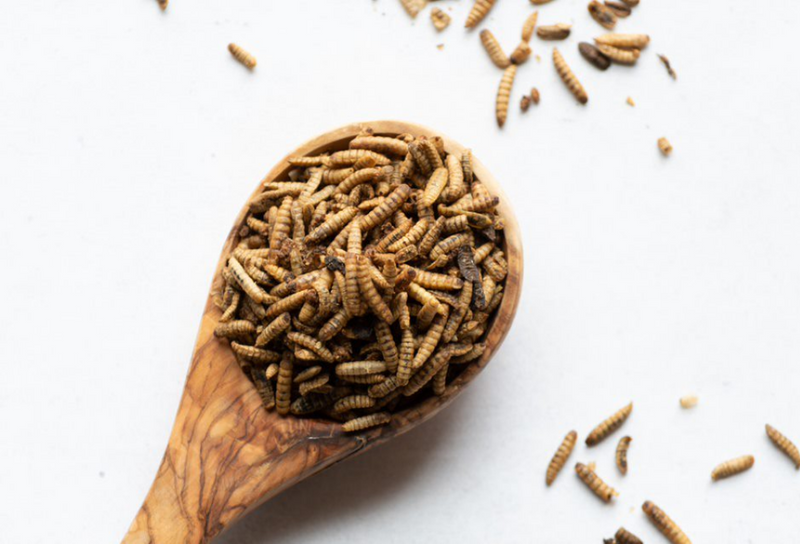If you’ve spent hours comparing chicken feeds online or in the store and have been left baffled by how they truly compare, you’re not alone. Understanding which feed is best for your flock can be difficult, and even frustrating. With countless claims and impressive packaging design, nearly every chicken feed boasts it’s the best. However, if you pare back the noise of slogans, brand names, and photos of healthy hens, you will find the key to comparing feeds. The secret to understanding feed is knowing what to look for and how to read the labels.
To make deciphering chicken feed nutritional labels simpler, we will cover what to look for, what to avoid, and how to decide which feed truly is the best diet for your flock.
Types of Chicken Feed
There are a lot of varieties of chicken feed and feed-like products available. We don’t cover chicken scratch in this article because it is not nutritionally adequate as a chicken’s primary diet.
Purpose & Appropriate Age
One of the first aspects of a feed you will want to decide on is what you need to provide for your individual flock. This is based on the age and purpose of your chickens. If you have a mixed flock, there are also a few considerations you will want to keep in mind.
Starter Feed
Starter feed is formulated for chicks up to 6 weeks of age. It offers high levels of protein (20% to 24%) to help young chicks start life with stronger muscles, a sharp mind, and what they need to aid in feather growth. A starter feed will also provide all the other nutrients your chicks need to develop into active and curious pullets and cockerels.
Grower Feed
Grower feed is made for chicks after 6 weeks and up to 20 weeks of age. It has lower levels of protein than starter feed (16% to 18%) yet does not have the elevated calcium levels that laying hens need to produce eggs.
One thing to keep in mind is that you do not want to provide your growing chicks, pullets, and cockerels with additional nutritional supplements. This can cause them to grow too fast or heavy for what their bodies are ready for.
Starter Grower Feed

Starter grower feed is formulated for chicks, pullets, and cockerels from day one to week 18 to 20 (depending on the formula). Starter grower chick feed offers the advantage of not needing to switch feeds and can minimize waste.
Learn about medicated and non-medicated chick feed.
Layer Feed

Layer feeds are formulated for laying hens. They offer a balance of protein, calcium, vitamins, minerals, and other nutrients to support healthy egg production. Most veterinarians suggest you switch laying hens to a high-quality layer feed once a hen lays their first egg or at 20 weeks of age.
Differing Feed Forms: Mash, Pellets, and Crumbles
One of the elements many chicken owners stumble on is the difference between pellets, crumbles, mash, and variations of the three. When comparing what texture is best for your flock, keep in mind that all forms of feed offer the same nutrients. They all just look and feel a bit different, and some flocks have an easier time adjusting to or eating one form over another.
Mash
Mash is the finest texture of feed you can purchase. It’s fully ground to the consistency of bread crumbs. Mash offers a thorough mix of all necessary nutrients, so each bite is balanced with ingredients.
However, ducks and other waterfowl struggle to swallow mash. Additionally, many chicken owners find mash to have higher levels of waste since it can easily be spilled and mixed in with their chickens’ bedding.
Most feeds begin as mash. From there, the feed is made into pellets then sometimes crushed into crumbles.
Crumbles

Crumbles are a middle ground between pellets and mash. The variation in texture resembles a chicken’s natural diet. This feed is soft and easy for chickens and ducks to eat. Many flock owners also find that transitioning their pullets and cockerels to a crumbled feed is easier than moving their growing birds to pellets since the feed more closely resembles starter grower feed. Crumbles are also convenient and easy for senior flock members to eat.
As for consistency, it is true to its name–imagine the pre-baked crumble you would top a pie with. More specifically, crumbled feed is ground, so the nutrients and ingredients are thoroughly distributed, but crumbles are not so fine that the feed can blow away.
As for drawbacks, some flock owners find their chickens exercising their natural instinct to scratch and forage for their crumbles by spilling some around their feeder. This can lead to a bit more waste than pellets. However, this can also be a great opportunity for your flock to engage in their contrafreeloading instinct.
Pellets

Pellets incorporate your flock’s feed into solid, long cylinders of food. At Grubbly Farms, our pelleted layer feed includes a medley of micro pellets, packed with nutrients and unprocessed, visible whole grains such as wheat, sunflower seeds, and barley. This reflects a chicken’s natural diet.
Many flock owners appreciate that pellet feed often comes with the least amount of waste and can be easy to store. However, pellets can be difficult for ducks to eat or swallow.
We also have a more complete guide on pellets versus crumbles if you want to learn more.
Other Poultry Feeds
When it comes to feeding your mixed flock, ducks, or other poultry, you will find you have more limited options on the market. Many flock owners also wonder if they have to feed their ducks or turkeys an entirely different feed than their chickens.
The reality is if a feed is formulated for a specific bird species, it is guaranteed to be properly balanced to meet their nutritional needs. However, this often comes with a steep cost increase.
You can modify your flock’s needs to better fit your species if you’re informed of your bird species’ specific needs. For example, many mixed flock owners will add additional brewer’s yeast to their chicken layer feed to meet the higher niacin need of their ducks. Other birds such as guineas, can also eat a high-quality layer feed with the addition of supplemental protein from a source like Grubblies.
Key Components of Chicken Feed Labels

The Association of American Feed Control Officials (AAFCO) regulates what is required to be stated on pet and animal food labels and what ingredients are deemed safe. This organization also mandates how foods can be named so that the product name accurately reflects its ingredients. The AAFCO requires eight items to be included on feed packaging.
Manufacturer’s Name & Address

The manufacturer’s name and address are a straightforward bit of information. Just keep in mind that if the label states “manufactured for” or “distributed by,” that product is actually made by a third party, but the company listed is responsible for the product’s quality. It’s not required for products to include an address, but they should have the manufacturing city.
When it comes to black soldier flies, you may notice that some U.S. companies take advantage of the rules surrounding addresses and do not include that their black soldier flies are grown and processed in China.
Product Naming
The AAFCO organization mandates how foods can be named so that the product name accurately reflects its ingredients. This is based on the percentage of an ingredient present within the food. For example, a food with grub flavor may only have trace elements of grubs–while a Grub Chicken Feed will have a much higher percentage of grubs as part of the formula.
Additionally, products labeled as treats or snacks must include a disclaimer that the product shouldn’t exceed 10% of the animal’s overall daily diet.
Intention & Species

It’s likely no surprise that the species a feed product is intended for must be included on the packaging. While this may seem straightforward, this can get a bit trickier for people that keep a mixed flock.
Weight or Net Volume

Again, you will notice every chicken feed includes the amount of feed you will receive.
While many flock owners often base value on the weight in comparison to the price of feed, this isn’t always the best measure of value. It’s important to keep in mind that more nutritious feeds are often more densely formulated. This means that chickens will get optimal nutrition with less feed–this means less waste. For example, feeds with corn fillers require that hens eat more feed to meet their nutritional needs.
Guaranteed Analysis

This section is designed to help flock owners compare the most important–essential–nutrients for hens’ health. All feeds must list the percentage of crude protein, crude fat, crude fiber, and moisture levels in their guaranteed analysis. Additionally, any nutrient that a product makes a claim about must clearly back up that claim within the guaranteed analysis. For example, if a feed says “High in calcium,” it must include the specific level of calcium within this section.
Here is what each guaranteed analysis element means:
- Crude Protein: The measure of how much protein is in a feed based on laboratory tests. This can include protein from meat or non-meat sources.
- Crude Fat: The amount of fat-soluble material within a feed, based on a random lab sample.
- Moisture: The approximate amount of moisture in a feed. Lower moisture often increases shelf life and many people feel that lower moisture indicates that the price of the product reflects its solid ingredients rather than ‘water weight.’
- Crude Fiber: The amount of cellulose, pentosans, lignin, and other indigestible fiber types as determined by chemical analysis.
- Lysine: An essential amino acid for chickens. Lysine is needed for a chicken to convert feed into usable energy and the elements for growth, the metabolic process, and egg production.
- Methionine: An essential amino acid required for fundamental bodily function, including the metabolic reaction of converting food into usable energy, and feather growth. Methionine allows a chicken’s body to absorb other much-needed amino acids.
- Phosphorous: Chickens require phosphorus to metabolize calcium and convert it into strong, healthy bones and eggshells.
- Calcium: This mineral is needed for circulatory system support along with the nervous system function and digestive system. Of course, it also aids in the reproduction cycle.
- Salt: Without salt, chickens cannot survive or maintain normal growth. Salt is also necessary for reproductive health, including egg production.
- Omega Fatty Acids: These nutrients support the immune and nervous systems, promote heart health, and promote a positive mood for chickens.
Ingredients

Every ingredient within a feed is required to be listed on the packaging. These ingredients must be listed from the highest to lowest percentage of the product's overall weight. This means if a feed is predominantly corn, corn must be listed first in the ingredients.
What to Look for or Avoid in Your Chicken Feed Ingredients
When it comes to chicken feed, you often get what you pay for. This is most apparent in a feed’s ingredients list.
Avoid Corn
Always opt for a feed that does not list corn as a top ingredient for the best value. Most chicken feeds use dent corn, which does not provide chickens with a lot of nutritional value other than empty calories. Additionally, cracked corn or ground corn loses its nutritional value.
Avoid Soy
Soy is a cheap way for feed producers to boost a feed’s protein and methionine levels. However, most soy used in feeds are GMO varieties and deplete the environment. Additionally, soy allergies are relatively common among chickens.
Soy-based feed can also pose an issue for people with soy allergies–both in handling the feed and eating the eggs soy-fed chickens produce.
Instead of soy, opt for peas, grubs, and brewer’s grains. Grubs, particularly black soldier fly grubs, are much higher in protein, phosphorus, omega fatty acids, calcium, and lipids than soybeans.
Most Veterinary Nutritionists Recommend a Diet That Reflects Nature
Chicken thrive on a diet that reflects what they (and their ancestors, Red Jungle Fowl) would naturally consume in the wild. This often includes what chickens would find and eat while foraging–primarily insects, grubs, seeds, nuts, and vegetation.
This means that feeds that provide natural prebiotics, probiotics, proteins, and other nutrients will often support the best gut health as well as reproductive health. Feeds that include Bacillus licheniformis, Bacillus subtilis, and Lactobacillus acidophilus can balance out the gut microbe–which has a major positive impact on chicken health. 90% of disease begins in the gut and 70% of all immune cells reside in the gut. So, when you feed and foster your flock’s gut health, you’re providing them with what they need to thrive.
Additionally, proteins and nutrients from insects and grubs, like black soldier fly grubs, offer a natural balance of essential amino acids. These include vital amino acids such as lysine and methionine, which chickens need to turn their feed into energy and for egg production.
Nutritional Adequacy
If a chicken feed makes the claim that it is “complete," "balanced," or "100% nutritious," it must be able to fulfill all of a chicken’s daily nutritional needs. This means it can be the sole diet for a chicken without the need for any supplements.
Feeding Directions & Serving Size

This section clarifies how much of the product you should feed your chickens daily. This amount is often determined by the chicken’s body weight.
Other Regulated and Non-Regulated Label Claims
Some claims do not require laboratory proof or certification while other claims do. For example, “premium” and “gourmet” are not defined by feed regulations. In fact, premium chicken feed can have identical ingredients to ordinary feed.
“Natural”
However, “natural” is defined by the AAFCO. This term means that the product does not contain artificial ingredients, including flavors, colors, or preservatives. A natural chicken feed can contain natural preservatives, though, including tocopherols (a source of Vitamin E).
“Certified Organic”
Products that are certified organic must be made from a minimum of 95% organic ingredients. This requires a product to go through the certification process with the USDA’s National Organic Program.
The NOP website defines “organic” products as:
“produced through approved methods that integrate cultural, biological and mechanical practices that foster cycling of resources, promote ecological balance and conserve biodiversity. Synthetic fertilizers, sewage sludge, irradiation, and genetic engineering may not be used.”
Organic Eggs
In an effort for flock owners to sell their eggs as “organic,” they opt for feeds with this labeling. However, it’s important to know that eggs cannot be labeled as “organic” if a chicken has been treated with antibiotics, hormones, or does not free-range.
Non-GMO
Non-GMO feeds are created without any genetically engineered ingredients. This approach to chicken feed reassures many flock owners that their chickens are eating the most natural and nutritious diet.
The Ideal Diet for Your Flock

Of course, reading the information on a chicken feed label only matters if you know what numbers are optimal for your feathered friends. It’s also important to note that most dietary guidelines for chickens outline the bare minimum your chickens need to thrive. Providing them with a few extra nutrients can help them better adapt to seasonal changes such as hot and cold temperatures, molting, and egg laying.
Learn more about how specific nutrients benefit your flock with our Complete Guide to What Chickens Can Eat.





